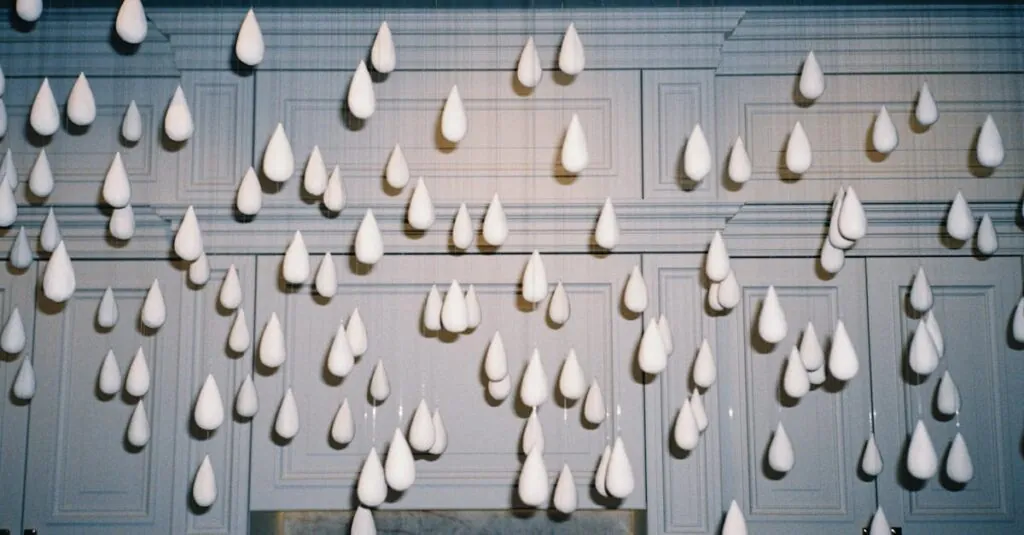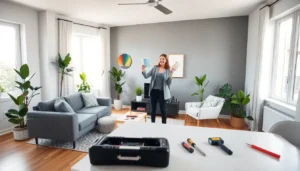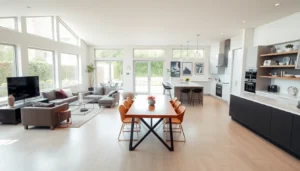Imagine walking into a room where the ceiling isn’t just a boring slab of drywall but a stunning architectural feature that steals the show. A coffered ceiling does just that, transforming an ordinary space into a masterpiece. It’s like giving your home a stylish haircut—suddenly, everything looks sharper and more refined.
Installing a coffered ceiling might seem daunting, but it’s easier than trying to assemble that IKEA furniture without the instructions. With a little patience and the right tools, anyone can elevate their home’s aesthetic. Not only does it add depth and character, but it also impresses guests who might think you hired a designer. So why settle for flat when you can go for fabulous? Let’s dive into the art of coffered ceiling installation and unlock the potential of your living space.
Table of Contents
ToggleOverview of Coffered Ceiling Installation
Coffered ceilings involve a grid of recessed panels that create depth and dimension. Correctly installed, they enhance aesthetics and improve overall room ambiance. Homeowners often choose materials like wood or drywall for frames, which significantly influence the ceiling’s final appearance.
Preparation includes measuring the ceiling height and determining the desired dimensions for panels. Measuring accurately ensures that all components fit together seamlessly. A suitable design layout, such as a traditional or contemporary style, can guide the installation process effectively.
Tools required for coffered ceiling installation include a chop saw, level, and nail gun. Each tool plays a crucial role in ensuring precision during assembly. Establishing a framework typically starts with attaching the perimeter molding, setting the stage for panel placement.
Panels come next; each should be cut to fit snugly within the framework. Utilizing adhesive as well as nails often secures them better.
Painting or staining enhances the coffered ceiling’s visual appeal. Many prefer a contrasting color to the wall for added emphasis, drawing attention to architectural details.
Final touches involve caulking seams and touching up paint for a polished look. Inspecting every corner guarantees that there are no visible gaps or imperfections. Commitment to these steps in creating a coffered ceiling brings homeowners closer to achieving a refined living space.
Benefits of Coffered Ceilings
Coffered ceilings offer numerous advantages that enhance both the look and value of a home. Homeowners often appreciate the striking aesthetic these ceilings provide.
Aesthetic Appeal
Coffered ceilings create a visually captivating element in any room. The recessed panels add depth, making a space feel more dynamic and inviting. Homeowners can mix materials and colors, allowing for personalization that complements existing decor. A well-designed coffered ceiling often draws the eye upward, creating an illusion of height. This architectural feature works effectively in various styles, from traditional to modern. With careful selection of finishes, the overall ambiance of the room can transform dramatically, elevating its decor and charm.
Increased Property Value
Investing in coffered ceilings can lead to a notable increase in property value. Many homebuyers seek unique architectural features like these as they enhance the aesthetic quality of living spaces. According to real estate experts, homes with added character often sell faster and at higher prices. Potential buyers recognize the craftsmanship involved in coffered ceilings, seeing them as a hallmark of quality. This feature not only improves the immediate appeal but also contributes positively to the overall marketability of a property. Thus, installing coffered ceilings serves as both an aesthetic upgrade and a strategic investment.
Materials for Coffered Ceiling Installation
Selecting the right materials is crucial for a successful coffered ceiling installation. Numerous types provide unique aesthetics and functionality.
Wood Options
Commonly, homeowners opt for wood because of its timeless appeal. Oak, cherry, and pine are popular choices, each offering distinct grain patterns. Oak delivers durability while cherry brings warmth and elegance, making it suitable for traditional settings. Pine, being cost-effective and lightweight, appeals to those on a budget. A clear finish or stain can enhance these natural hues, allowing the wood to shine.
Alternative Materials
Alternative materials provide innovative options for coffered ceilings. MDF (medium-density fiberboard) is engineered for uniformity and affordability, making it a practical choice. It accepts paint well, allowing for versatile color coordination with existing decor. Additionally, polystyrene offers lightweight and moisture-resistant benefits, perfect for humid environments. This synthetic material mimics the appearance of wood without the weight or expense, catering to various design preferences.
Installation Process of Coffered Ceilings
The installation of coffered ceilings requires careful preparation and execution to achieve an elegant finish. Proper planning lays the foundation for a successful project.
Pre-Installation Preparation
Measuring ceiling height and determining panel dimensions is crucial for ensuring a seamless fit. Selecting the right materials significantly impacts both aesthetics and durability. Homeowners often opt for wood or drywall frames; oak, cherry, and pine each provide unique characteristics. Furthermore, MDF and polystyrene serve as innovative alternatives that cater to budget-friendly and moisture-resistant needs. Gathering essential tools like a chop saw, level, and nail gun ensures precision throughout the installation process. Laying out a clear installation plan can help visualize the grid layout and overall design.
Step-by-Step Installation Guide
Starting the installation involves attaching perimeter molding around the ceiling’s edges. Cutting panels to fit within the framework comes next, making use of precise measurements. Secure panels in place using a nail gun to ensure stability and longevity. Painting or staining the ceiling often enhances the overall aesthetic; a contrasting color can bring out details. Caulking seam lines for a clean finish signifies the final touch in the process. Inspecting the completed ceiling for imperfections guarantees a polished look that elevates the entire space.
Cost Considerations
Coffered ceiling installation costs vary based on several factors, primarily materials and labor. Understanding these expenses helps homeowners plan effectively for this enhancement.
Budgeting for Materials
Materials play a significant role in overall cost. Wood options like oak, cherry, or pine usually range from $2 to $12 per board foot. MDF and polystyrene offer cost-effective alternatives, priced between $1 and $5 per linear foot. Homeowners may expect additional costs for finishing materials such as paint and caulk. Budgeting for tools also matters; tools like saws and nail guns can add $100 to $300 to initial spending. Selecting materials that align with both aesthetics and budget enables homeowners to maximize style while managing costs.
Labor Costs
Labor costs depend on project complexity and location. Hiring a professional contractor typically ranges from $30 to $75 per hour. Installation of coffered ceilings often requires skilled labor due to the precision necessary for a polished finish. Depending on room size, a project might take 15 to 25 hours. Homeowners considering a DIY approach can save on these costs but must factor in their own time and potential learning curves. Proper budgeting for labor ensures a smooth installation process while achieving desired results.
Conclusion
Coffered ceilings offer a remarkable way to elevate any room’s design while adding depth and character. With the right tools and a bit of patience homeowners can transform their spaces into inviting and stylish environments. The benefits extend beyond aesthetics as these ceilings can significantly increase property value making them a smart investment for the future.
By carefully selecting materials and following a structured installation process homeowners can achieve stunning results. Investing time in planning and execution will ensure a polished finish that impresses guests and enhances everyday living. Embracing this architectural feature is a decision that pays off both visually and financially.





